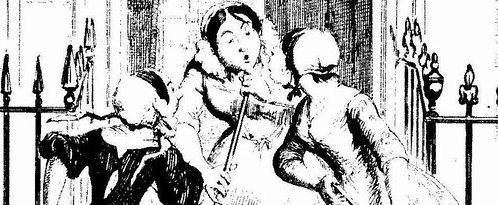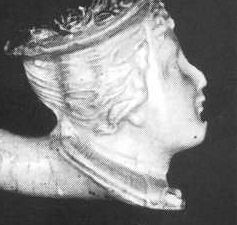What the Romans did TO us (i.e. women)
A recent popular history television series ran along the lines of What the Romans Did For Us - with lists of all the usual "civilising influences" - "concrete, fast food to frescos and lighthouses to loos".
Yet having just finished Boudicca's Heirs, by Dorothy Watts, I also know what the Romans did to "us" - if you count the (roughly, very roughly in their case) half of the population that is female as "us". Watts work is subtitled "Women in Early Britain" and is an up-to-date (2005) account of what the archaeological record reveals (with also notes of how this matches the historical record).
The overwhelming, almost shattering, fact is that while in the preceding Iron Age numbers of men and women were pretty much matched, soon after the Romans arrived there is a suddenly shift in the nation's graveyards - the number of women drops significantly. The only explanation, Watts concludes, is that the Romans brought with them, with all their "civilising" influences, the previously unknown practice of female infanticide - and female infanticide to the level of the worst of India or China today, that saw up to seven per cent of the women "lost".
You might ask where the babies' bodies went, but the Roman practice was that infants and young children were not -- at least until the influence of Christianity -- buried in "adult" graveyards, but in domestic or city contexts where bones, if they survive at all, will only occasionally be found. Also, children being abandoned were usually just dumped, rather than killed, so their bodies would usually have fallen to scavengers.
It is worth noting too that when the Romans went, so did the practice of female infanticide. (Although the arrival of Christianity does appear to have ameliorated it.) It was only in the Saxon burial grounds, however, the sex ratio is restored to natural equality.
Watts's writing is often technical and detailed (she goes into all the statistics and the potential factors that contributed to them) - this is certainly not an "introduction to the women of Roman Britain book" - yet in the end her conclusions are clear, if undramatically presented:
"In Chapter 2 the burial evidence was extrapolated from 16 sites from the late pre-Roman Iron Age. It was shown that there were equal numbers of males and females in Iron Age cemeteries. When those figures are compared with those of the Roman period (M=57 per cent, F = 43 per cent), it is obvious that there was a decline in the number of females being reared." (p. 53.)
Even those women who survived this early danger were likely, the archaeological evidence suggests, to see their status decline as Roman influence took hold:
"In most sites in the Iron Age females had larger and deeper graves than men. The graves with the largest dimensions were in fact for women from the earliest cemeteries studied - the Aras burials in East Yorkshire, dating from the third to the early first century BC." (p. 72)
Yet, Watts makes clear, the archaeological evidence suggests that women could have strong positions within elite families - being in higher numbers than males among what she describes as "status" burials - those that featured lead and stone coffins, and/or had the bodies packed with variously constituted "plaster", which probably started as a Christian practice to try to preserve the body for Judgement Day, but then spread more widely. But the top men were most likely given even more status in death, in mausolea, vaults and enclosures, which are overwhelmingly given over the male bodies.
Also, that doesn't mean girls, once they had been chosen for survival, were not valued. The graves of adolescents and young women are frequently rich and well marked. Indeed, she suggests that there was for girls who died before marriage were "dowered" in some way in the grave, in a ritual for which it appears there is no literary record.
"At Dunstable, a teenage girl had three bronze bracelets on her left wrist, two bronze and one iron ring on her left hand, and a necklace comprising 61 small glass beads around her neck; an 18-year-old also had a pile of jewellery in her coffin ... At Lankhills, a young woman aged 17-20 had, besides a spindle whorl and hobnailed footwear, seven bravelets, two rings and some beads..." (p. 83)
Wherever possible (which isn't all that often), Watts records the human details behind the archaeological statistics. These are the simple human tragedies that could be Any Time, Any place. Simplicia Florentina was aged just 10 months when she died in York, mourned by her father, a soldier of the Sixth Legion. Her coffin refers to her as a "most innocent soul". That, combined with her name, suggests the family was Christian, as does the enclosure of the child's body in plaster. (p. 145)
That story might be balanced by that of Claudia Crysis, who died at Lincoln at the advanced age of 90. Probably a freed slave, her name came from the Greek, meaning gold, and she must have had golden luck to have lived to such an age in Britain, for one of the things that emerges, perhaps surprisingly, is that few people lived beyond the age of 45, unsurprisingly given the evidence of their bones, which show rampant malnutrition, particularly outside the wealthier urban centres, the dangers of childbirth, and the rates of infectious disease.
Beyond the evidence of the graveyards (so information-rich and as Watts says, with advances in DNA technology likely in the future to yield far more data), she conducts a brief survey of what can be known about the lives of these women before they reached their final resting place - their daily work and leisure activities, their religious beliefs and activities. The answer still, all too often, is "we don't know".
This is, however, a fast-moving area - with an enormous amount of data added to the records every year, even if only the occasion "sexy" find makes the newspaper headlines. To give just one example, Watts notes that in her study of 1991 she concluded there were 13 cemeteries in fourth-century Britain that might be seen as Christian. Just over a decade later "to that list might now be added the cemeteries at Bletsoe, Newarke Street Leicester, and Shepton Mallet." (p. 147) It seems unlikely, however, that the basic conclusion of what the Roman did to us will be overturned.







5 Comments:
Fascinating information. While reading your post, I was marveling at the fact that the “other side” rarely gets told, and when it does it is often labeled as blatantly (and often negatively) “feminist.” It’s incredible how the male perspective is so inherent in the information we receive – and yet to remark on this observation is considered radical.
Indeed. I suspect most "mainstream" (or should I say "malestream"?) texts will mention this imbalance, possibly in a footnote, then move on to more "interesting" statistics (about men)...
I wonder what the motivation was ? Cultural preference as in India ?
Slightly off topic - moving from the Romans killing infants to people aborting them.
Is it your contention that aborting babies in an equal opportunities fashion is acceptable, but not otherwise ?
Very interesting information. How was it I wonder that an unbalanced population served the supposed interests of the roman society? It certainly seems strange to us now. The Hindu preference for sons will have effects which remain to be seen, but I expect the effects of population overgrowth and global warming of an already almost inhumanly hot environment there will make identifying the effect hard to isolate in that part of the world. As to abortions being more or less acceptable for females or males, I would say they are equally acceptable but equally regrettable as well. Humanity can do better, if religious people's obstructions can be overcome.
Did the author consider that some of the vanished girls might have gone into the slave trade?
Post a Comment
<< Home